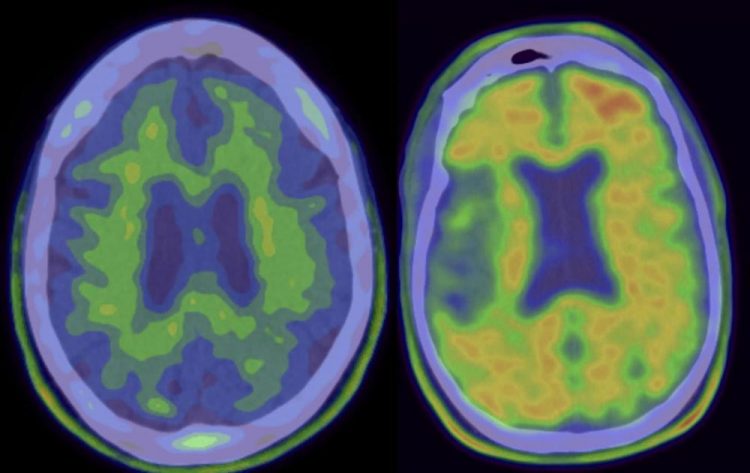Alzheimer's drug targeting soluble amyloid falls short in a large clinical trial

LEFT: "Negative" scan, without Alzheimer's disease pathology. RIGHT: "Positive" scan of patient eligible for Solanezumab clinical trial. Credit: Columbia University Medical Center
Researchers have proposed that Alzheimer's disease is caused by the buildup of a sticky protein called beta-amyloid. According to this 'amyloid hypothesis,' the protein forms plaques in the brain that damage and eventually destroy brain cells. Solanezumab was designed to reduce the level of soluble amyloid molecules before they aggregate.
A total of 2,129 patients with mild dementia due to Alzheimer's disease participated in the double-blind, placebo-controlled, phase 3 multicenter trial. This study was the first major Alzheimer's clinical trial to require molecular evidence of amyloid deposition in the brain for enrollment.
While the treatment did have some favorable effects, in the main measure of outcome–measured with a cognitive test called the Alzheimer's Disease Assessment Scale-cognitive subscale–the researchers did not observe any statistically significant benefit compared with placebo.
The authors suggest that while it is not certain that this particular strategy or drug could be effective, it is possible that either not enough drug was administered or that the drug needs to be administered earlier in the disease course.
In other studies ongoing at CUIMC, solanezumab is being evaluated in presymptomatic patients at risk of Alzheimer's disease. Other Alzheimer's drugs are also in development and being tested at higher doses.
“Although we are disappointed that this particular drug did not prove successful, the field is benefiting from each study,” says lead author Lawrence Honig, MD, PhD, professor of neurology at CUIMC. “There is hope that one of the newer ongoing studies may result in an effective treatment for slowing the course of Alzheimer's disease.”
###
The results of this study were first released in late 2016 at the international Clinical Trials on Alzheimer's Disease meeting in San Diego.
The study is titled, 'Trial of Solanezumab for Mild Dementia Due to Alzheimer's Disease.'
Additional authors are Bruno Vellas, M.D., Michael Woodward, M.D., Merc. Boada, M.D., Ph.D., Roger Bullock, M.D., Michael Borrie, M.B., Ch.B., Klaus Hager, M.D., Niels Andreasen, M.D., Ph.D., Elio Scarpini, M.D., Hong Liu Seifert, Ph.D., Michael Case, M.S., Robert A. Dean, M.D., Ph.D., Ann Hake, M.D., Karen Sundell, B.S., Vicki Poole Hoffmann, Pharm.D., Christopher Carlson, Ph.D., Rashna Khanna, M.D., Mark Mintun, M.D., Ronald DeMattos, Ph.D., Katherine J. Selzler, Ph.D., and Eric Siemers, M.D. Their affiliations are listed in the appendix of the paper.
The study was designed and funded by Eli Lilly and Company.
Columbia University Irving Medical Center provides international leadership in basic, preclinical, and clinical research; medical and health sciences education; and patient care. The medical center trains future leaders and includes the dedicated work of many physicians, scientists, public health professionals, dentists, and nurses at the College of Physicians and Surgeons, the Mailman School of Public Health, the College of Dental Medicine, the School of Nursing, the biomedical departments of the Graduate School of Arts and Sciences, and allied research centers and institutions. Columbia University Irving Medical Center is home to the largest medical research enterprise in New York City and State and one of the largest faculty medical practices in the Northeast.
For more information, visit cumc.columbia.edu or columbiadoctors.org.
Media Contact
All latest news from the category: Health and Medicine
This subject area encompasses research and studies in the field of human medicine.
Among the wide-ranging list of topics covered here are anesthesiology, anatomy, surgery, human genetics, hygiene and environmental medicine, internal medicine, neurology, pharmacology, physiology, urology and dental medicine.
Newest articles

Superradiant atoms could push the boundaries of how precisely time can be measured
Superradiant atoms can help us measure time more precisely than ever. In a new study, researchers from the University of Copenhagen present a new method for measuring the time interval,…

Ion thermoelectric conversion devices for near room temperature
The electrode sheet of the thermoelectric device consists of ionic hydrogel, which is sandwiched between the electrodes to form, and the Prussian blue on the electrode undergoes a redox reaction…

Zap Energy achieves 37-million-degree temperatures in a compact device
New publication reports record electron temperatures for a small-scale, sheared-flow-stabilized Z-pinch fusion device. In the nine decades since humans first produced fusion reactions, only a few fusion technologies have demonstrated…





















